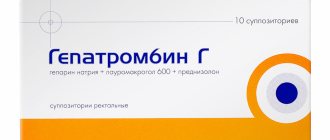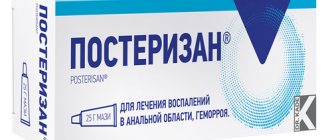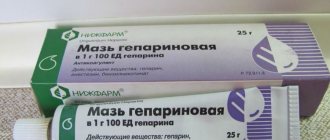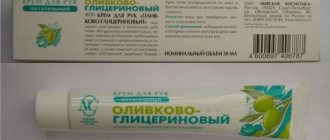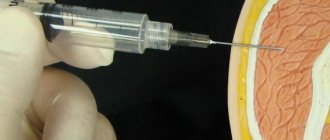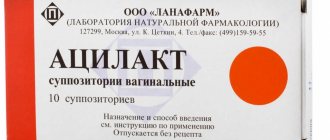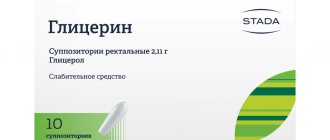A whole line of medicines is produced under the name “Hepatrombin”. To treat hemorrhoids, Hepatrombin G is used, which is available in the form of ointments and suppositories for rectal administration. The drugs can be used simultaneously: treat external manifestations of varicose veins of the rectum and anus with ointment, and insert suppositories into the rectum.
Pharmacological composition of the drug
Gepatrombin suppositories contain three active components that provide a large-scale therapeutic effect:
- sodium heparin;
- hormone prednisolone;
- lauromacrogol.
Additional ingredients designed to maintain the shape and improve the effect of medicinal substances include: colloidal silicon dioxide, solid fat, medium chain triglycerides, glyceryl tristearate.
Each suppository has a white color without inclusions, a homogeneous structure and a conical shape for ease of administration.
Packaged in five pieces in plastic blister packs. One box contains 10 suppositories and instructions for use.
Composition and dosage forms
Hepatrombin G contains several active components that complement each other’s effectiveness:
- heparin sodium: a direct anticoagulant that prevents the formation of blood clots;
- lauromacrogol 600: anesthetic agent with sclerosing effect;
- prednisolone: a glucocorticoid hormone with anti-inflammatory and antiallergic effects.
Gepatrombin G is produced in forms for topical use:
- Ointment: a viscous, homogeneous substance of light cream color with a waxy texture; in addition to active substances, it contains auxiliary and formative substances: paraffin, silicon dioxide. The ointment also contains lanolin, which accelerates tissue healing. The drug is packaged in 20 ml metal tubes equipped with special elongated tips for ease of use.
- Suppositories: torpedo-shaped rectal suppositories on a fat basis. Contains hard wax, triglycerides, silicon dioxide, glycerol and other form-building neutral substances. The drug is packaged in plates with individual cells, each containing 5 suppositories. There are 10 doses in one package of the drug.
How do Gepatrombin G suppositories work?
The drug belongs to a combination drug and has the following effects:
- relieves inflammation and pain in the rectal area;
- reduces the formation of blood clots;
- relieves obsessive itching;
- relieves swelling of the mucous membrane of the anus and rectum;
- promotes the resorption of hemorrhoids.
Therapeutic effects are achieved through:
- heparin, which has antithrombotic, anti-edematous and anti-inflammatory effects, improves the regeneration of damaged tissue;
- glucocorticosteroid prednisolone with powerful anti-inflammatory and antipruritic effects;
- lauromacrogol, which helps relieve pain and reduce swollen veins.
The medicinal composition of the suppositories affects the course of the pathology: it reduces the severity and relieves acute symptoms, thereby making it possible to lengthen the period of remission and effectively prepare for surgery to eliminate the disease.
Basic principles of treatment of hemorrhoids in pregnant and postpartum women
G
Emorrhoids are one of the most common human diseases. The main reasons for this are the vertical position of the body, diet, sedentary work and adynamia. It is generally accepted that hemorrhoids occur significantly less often in women than in men. However, studies have shown that hemorrhoids are quite common among women, but most of them do not attach any importance to it and do not consult a doctor.
The manifestation or exacerbation of hemorrhoids in women occurs mainly during pregnancy and childbirth, which is associated with blood stagnation due to increased intra-abdominal pressure. Constipation, which often occurs in pregnant women due to a hypotonic state of the rectum, can also be a provoking factor. Constipation is observed in 53% of pregnant women, including in 86% of cases with hemorrhoids. As your pregnancy progresses, the likelihood of developing hemorrhoids increases. However, in women with a family predisposition to venous pathology, as a rule, hemorrhoids appear already in the first – early second trimester, because stagnation of blood in the veins of the pelvis and lower half of the body aggravates both the pathology of the cavernous tissue of the rectum and the veins of normal structure. The question of the primary or secondary development of hemorrhoids in pregnant women has not been fully studied and is presented in the literature by diametrically opposed points of view, which does not reduce its relevance for practitioners who are daily faced with the problem of its treatment. It has also been noted that hemorrhoids occur more often during the first and second pregnancies than during subsequent ones.
Hemorrhoids manifest themselves in the form of two main syndromes - an acute attack and a chronic course of the disease.
The basis for the development of acute hemorrhoids is most often thrombosis of hemorrhoids. Thrombosis of hemorrhoids is characterized by their enlargement and compaction and is accompanied by pain in the anus. Thrombosis usually begins in the internal nodes and subsequently spreads to the external ones. This process is usually accompanied by severe pain in the anus. Less common is isolated thrombosis of external nodes, manifested as a dense, rounded formation.
A typical symptom complex of the chronic course of the disease consists of repeated bleeding, most often associated with defecation and prolapse of hemorrhoids from the anus. Quite often, all these signs are combined with anal itching or a feeling of burning, weeping, and rawness in the anus.
External hemorrhoids are distinguished
, formed from the lower venous plexus and located directly under the skin of the anus, as well as
internal hemorrhoids
, formed from the upper venous plexus and located in the submucosal layer of the rectum.
Bleeding, as the leading symptom of hemorrhoids, is observed in more than half of patients. The second most common symptom of hemorrhoids is prolapse of hemorrhoids. This disease also causes symptoms such as anal itching (9%), discomfort in the anal canal (5%), and mucus discharge (2%).
All of the above, naturally, does not contribute to the normal course of pregnancy. Therefore, if hemorrhoids exist, but do not cause particular concern, it is necessary to prevent complications. First of all, it is necessary to regulate the frequency of bowel movements. This procedure should occur at the same time every day. With the help of a diet, they try to avoid constipation and perform gymnastic exercises. The diet should be rich in vegetables and fruits with a moderate amount of meat and carbohydrates, dairy products and black bread are healthy. Hygiene of the anus area is very important. You need to wash yourself with cold water after each bowel movement. External hemorrhoids do not require surgical treatment. Internally, in most cases, you can limit yourself to drug therapy.
Currently, medications have appeared on the Russian pharmaceutical market that can be used with great effect in the treatment of this pathology.
The purpose of this study
was an assessment of the effectiveness and tolerability of Gepatrombin G (ointment and rectal suppositories) in the treatment of hemorrhoids in pregnant and postpartum women.
Clinically, the symptom complex of hemorrhoids during pregnancy
was almost no different from that among other categories of patients with this diagnosis. Of 232 pregnant women with clinical signs of hemorrhoids, pain in the anus was observed in 46.1%, rectal bleeding in 37.1%, and anal itching in 27.6%. Often, the observed women had external hemorrhoids (61.3%), characterized by the appearance of hemorrhoids in the form of warty formations or folds, dense to the touch and not decreasing in volume upon palpation. In internal hemorrhoids (38.7%), the nodes were located between the folds of the mucous membrane, could be either single or multiple, collapsed when pressed and filled when coughing. In 11.5% of cases, hemorrhoids were combined with an anal fissure. Often, pregnant women, after a 2-3-day delay in stool, suddenly developed painful, dense hemorrhoids, which was accompanied by acute pain and, less often, bleeding. It should be noted that if in pregnant women aged 20 to 30 years, hemorrhoids were detected in approximately every fifth, then after 30 years - in every second.
From our point of view, for practice it is advisable to distinguish three groups of pregnant women suffering from hemorrhoids
. We included asymptomatic hemorrhoids in the first group. These women underwent preventive measures, including a diet with limited spicy foods and a sufficient amount of plant fiber, physical therapy, walks, anal water toilet after defecation, and laxative herbs. Timely identification of pregnant women with clinically asymptomatic hemorrhoids and implementation of such preventive measures in them makes it possible to prevent the development of the disease, which complicates the course of childbirth and the postpartum period.
The second group consisted of patients with complaints of bleeding, anal itching, and pain during defecation. These women, in addition to the above measures, were treated with suppositories and Gepatrombin G ointment from the second trimester.
The third group included pregnant women suffering from hemorrhoids subject to surgical treatment. These were three women with large prolapse of internal nodes and with a history of frequent exacerbations, patients with profuse debilitating hemorrhoidal bleeding, as well as with acute hemorrhoids in the stage of necrosis of the prolapsed strangulated nodes. Pregnant women were consulted by a proctologist, with whom further management tactics were developed. These patients were also prescribed Hepatrombin G for preoperative preparation according to individual regimens.
Gepatrombin G
is a combination drug that contains 3 active components - heparin, prednisolone, polidocanol. Heparin is a direct anticoagulant that activates antithrombin III, neutralizing a number of factors (XIIa, XIa, Xa, XIIIa), and disrupts the transition of prothrombin to thrombin. When applied topically, heparin prevents the formation of blood clots, has an anti-edematous and anti-inflammatory effect, and promotes the regeneration of connective tissue. Prednisolone is a synthetic glucocorticoid that has anti-inflammatory and antiallergic effects, reduces itching and burning sensation. Polidocanol is a compound of the polyethylene glycol group that has a local sclerosing and analgesic effect. Thus, the pharmacological effect of this combination drug for the treatment of hemorrhoids is associated with local anesthetic, anti-inflammatory, antithrombotic, antispasmodic and antipruritic effects.
Gepatrombin G ointment was used for external hemorrhoids, applied to the affected areas in a thin layer 2–4 times a day, and after the pain disappeared, once a day for 7 days. Gepatrombin G suppositories were used for internal hemorrhoids 2 times a day for 5–7 days, after the disappearance of painful sensations, once a day for another 7 days.
The severity of remaining clinical symptoms was assessed by patients as moderate by day 7 of treatment and weak by day 15.
Clinical tolerability was assessed by patients and doctors on a scale: excellent, good, average, poor. Tolerability of treatment with Gepatrombin G was excellent and good in 95% of cases.
Pregnancy, although not the main pathogenetic factor of hemorrhoids, often reveals it and aggravates its clinical course. On the other hand, hemorrhoids in pregnant women often complicate the course of childbirth and the postpartum period. During labor, when the head passes through a narrow part of the pelvic cavity, compression occurs on the vessels of this area, including the rectum. Disrupted venous outflow and blood stagnation create additional conditions for the opening of arteriovenous anastomoses directly into the lumen of the cavernous cavities of the rectum. During pushing, as is known, the anal sphincter opens, the distal end of the rectum gapes, and at the same time both external and internal hemorrhoids are clearly visible. When the fetal head erupts, the internal nodes, if they are sufficiently pronounced, are squeezed out and sometimes their walls are torn. After childbirth, with a gradual contraction of the anus, the internal nodes contract and correct themselves. If the sphincter contracts quickly, these nodes are pinched and acute hemorrhoids occur.
In our study, Gepatrombin G ointment was used in postpartum women
(87 people) with hemorrhoids of I–II severity (4 times a day for the first 2–3 days, then 1–2 times a day until discharge). In some patients, despite a noticeable reduction in nodes in the first days of treatment, pain persisted during defecation, which served as the basis for prescribing cleansing enemas with preliminary introduction of 30–40 g of petroleum jelly into the anus. By the time of discharge, all observed postpartum women considered themselves healthy and were discharged in satisfactory condition.
Thus, the study allows us to conclude that the use of the drug Gepatrombin G, both in the form of an ointment and in the form of rectal suppositories, is an effective way to treat pregnant and postpartum women with hemorrhoidal crises.
The speed of action and good tolerability of the drug allows us to recommend it for widespread use in obstetric and gynecological practice. Literature:
1. Rivkin V.L., Kapuller L.L. Haemorrhoids. M., Medicine, 1984, 176 p.
2. Shekhtman M.M. Haemorrhoids. // 9 months, 2001; 10:11.
3. Contou J. Complications des hemorroides. // Rev. med., 1997; 22 (20): 1199–205.
4. Muller–Lobeck H. Hemorrhoids: trends in treatment. // Chirurg, 2001; 72 (6): 667–76.
5. Wasvary HJ, Hain J, Mosed–Vogel M et al. Hemorrhoids // Dis. Colon Rectum, 2001; 44(8):1069–73.
For what diseases is Hepatrombin G prescribed?
Suppositories are prescribed for external and internal localization of hemorrhoids, as well as in the treatment of:
- inflammatory process in the veins of the anus and rectum with the formation of blood clots;
- defects and wounds of the anal mucosa - cracks and fistulas.
Proctologists recommend Hepatrombin G at the preparatory stage for surgery on the rectum or anus, in the complex therapy of hemorrhoidal thrombosis, and when monitoring hemorrhoids after surgery.
Gepotrombin suppositories are a powerful drug, therefore they are used in the treatment of advanced hemorrhoids, as well as those complicated by thrombosis of the rectal veins.
When is it prohibited to use Gepatrombin G?
It is necessary to refuse therapy with suppositories and ointments:
- with reduced blood clotting, bleeding from the anus;
- oncological benign and malignant intestinal tumors;
- with infectious lesions of the rectum, the presence of parasites;
- for tuberculosis, syphilis;
- fungal, bacterial lesions of the skin and mucous membranes;
- in case of individual intolerance to the components of the drug.
Signs of a possible allergic reaction to Hepatrombin G: increased itching and severe burning a few hours after administration of the drug, sensation of a foreign object in the rectum, increased dryness of the mucous membrane.
Contraindications and unwanted effects
The instructions for Gepatrombin suppositories contain a list of pathologies and conditions for which the medication is not prescribed:
- excessive sensitivity to the substances included in the product;
- skin infections of a bacterial, viral or fungal nature;
- neoplasms of the skin;
- tuberculosis;
- local reactions to vaccination;
- syphilis;
- tendency to bleed;
- initial stages of pregnancy.
Side effects do not exclude local manifestations of allergies, redness of the skin and burning. Use longer than recommended carries the risk of unwanted systemic manifestations of glucocorticoid hormones.
Dosage and method of administration
Apply externally. The ointment is applied with light rubbing movements to a well-cleaned area of the skin 1-3 times a day. For a one-time application, a column of ointment 5 cm long is enough. To achieve the maximum therapeutic effect, it is recommended to rub in the ointment not all at once, but in separate portions.
In case of thrombosis and thrombophlebitis, it is not recommended to massage the skin when applying the ointment, as this can provoke the detachment of a blood clot and the development of a life-threatening condition for the patient.
When treating varicose veins, the drug can be used by applying it to a gauze bandage. Trophic ulcers without violating the integrity of the skin are treated by applying ointment in the form of a ring with a diameter of up to 4 cm.
Price, reviews of Gepatrombin G candles
The price of Gepatrombin G suppositories depends on the pricing policy of the pharmacy chain; the average cost for 10 suppositories is 320 rubles. You can buy the product without a prescription.
Reviews about Gepatrombin G suppositories online are positive. Patients note the rapid action of the composition and help in solving a delicate problem. For some, the medication helped cure chronic hemorrhoids, which developed due to the ineffectiveness of other topical medications. The advantages include an affordable price, as well as the ability to treat hemorrhoids located inside the rectum.
Doctors often prescribe suppositories as monotherapy, or as part of a complex therapy for a complicated course of the disease. Most proctologists recommend using suppositories together with ointment for external use. The product copes well with swelling and discomfort.
Pharmacodynamics and pharmacokinetics
This combined drug is actively used in proctology, exhibiting antithrombotic, anti-inflammatory and venosclerotic effects.
Its main component, heparin , is a well-known direct-acting anticoagulant. It is also characterized by increasing the ability to regenerate connective tissue and preventing blood in the area of hemorrhoids.
As for prednisolone , which belongs to GCS, it exhibits anti-inflammatory, antiexudative and antiallergic effects, reducing itching and burning sensations, pain in the anorectal area.
Lauromacrogol 400 or polidocanol has a local anesthetic effect, providing sclerosis in the area of hemorrhoids .
Penetrating into the body, Hepatrombin G ointment, like suppositories, undergoes biotransformation in the liver and reticuloendothelial system. Plasma protein binding can reach at least 95%. The drug is excreted through the kidneys in several stages.
